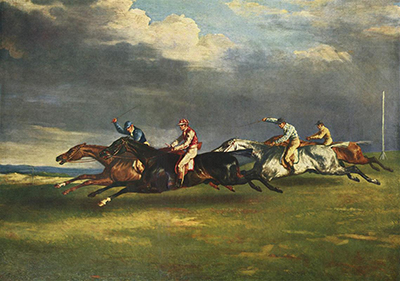The Epsom Derby of 1821 was captured by Theodore Gericault on an extended visit to the UK.
This famous French Romanticist did not produce many paintings during this spell as most of his work was with lithographs at this time. The artwork also stands out as unique in terms of its content when compared to the other highlights from his career, which tend to be religious or military based, as with Raft of the Medusa, The Wounded Cuirassier and The Charging Chasseur.
The combination of equestrian form with the cultural display of a day at the races will appeal to many. Edgar Degas is perhaps the best known for capturing horse racing and saw it as a new challenge having mastered the human figure, such as with his ballerinas. It took many centuries for landscape scenes to become so prevalent within art history and Gericault takes this opportunity to implement his own right across the background, though in a style which supports rather than takes away from the main focus of the piece.
The original work sits in the Louvre in Paris, alongside several other significant Gericault paintings, under it's original French name of Le Derby de 1821 à Epsom. It stands at 123cm by 92cm which is smaller than some of his other works but is comfortable at that size because most of the scene is fairly subtle. Whilst not painting race horse scenes often, the artist did study the form of this animal over an extended period as a guest to several stables earlier in his career. This enabled him to understand the particular challenges that were posed against his use portraits of the human body.
Whilst now residing at the Louvre in Paris, it was initially produced for Adam Elmore, who was a horse dealer, relatively local to Epsom itself. His commission request fitted in perfectly with one of his passions as an artist and also fitted well with his trip to England to understand its culture and history a little better. It was purchased by the Louvre as far back as 1866.




